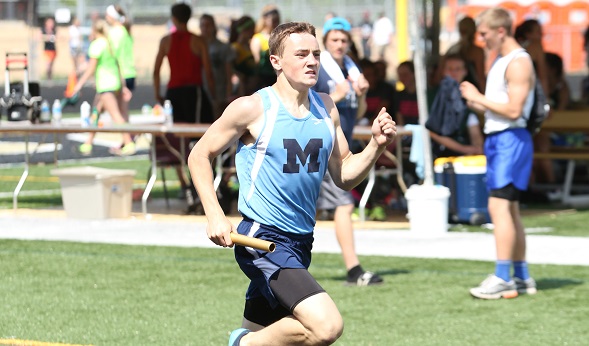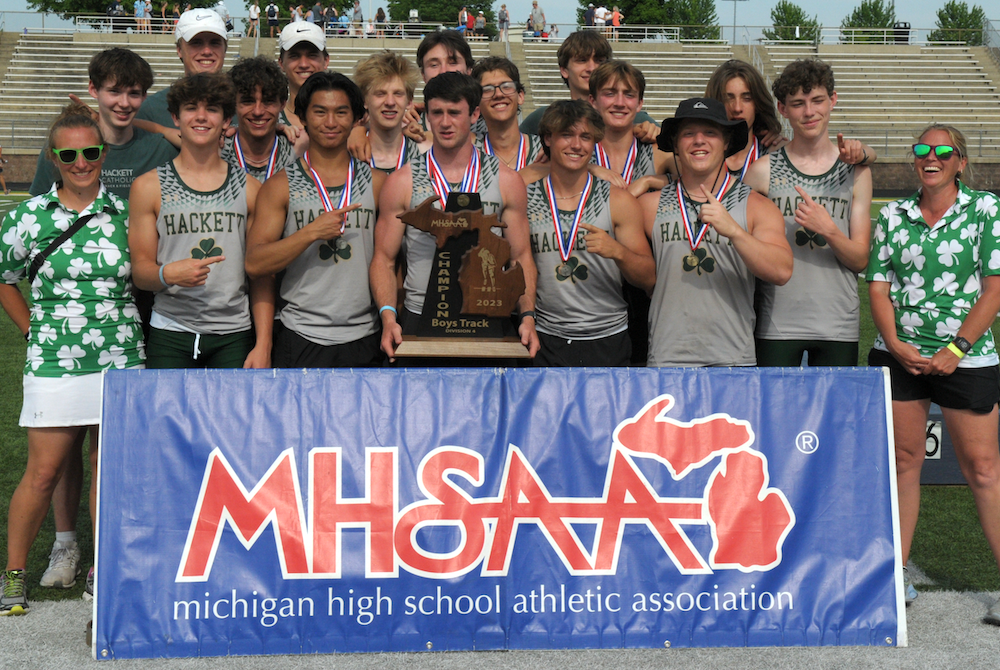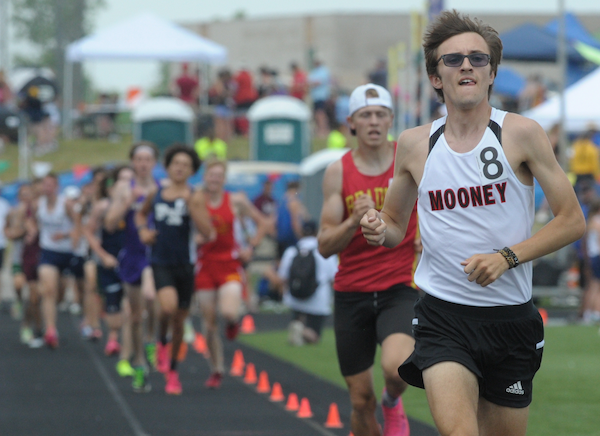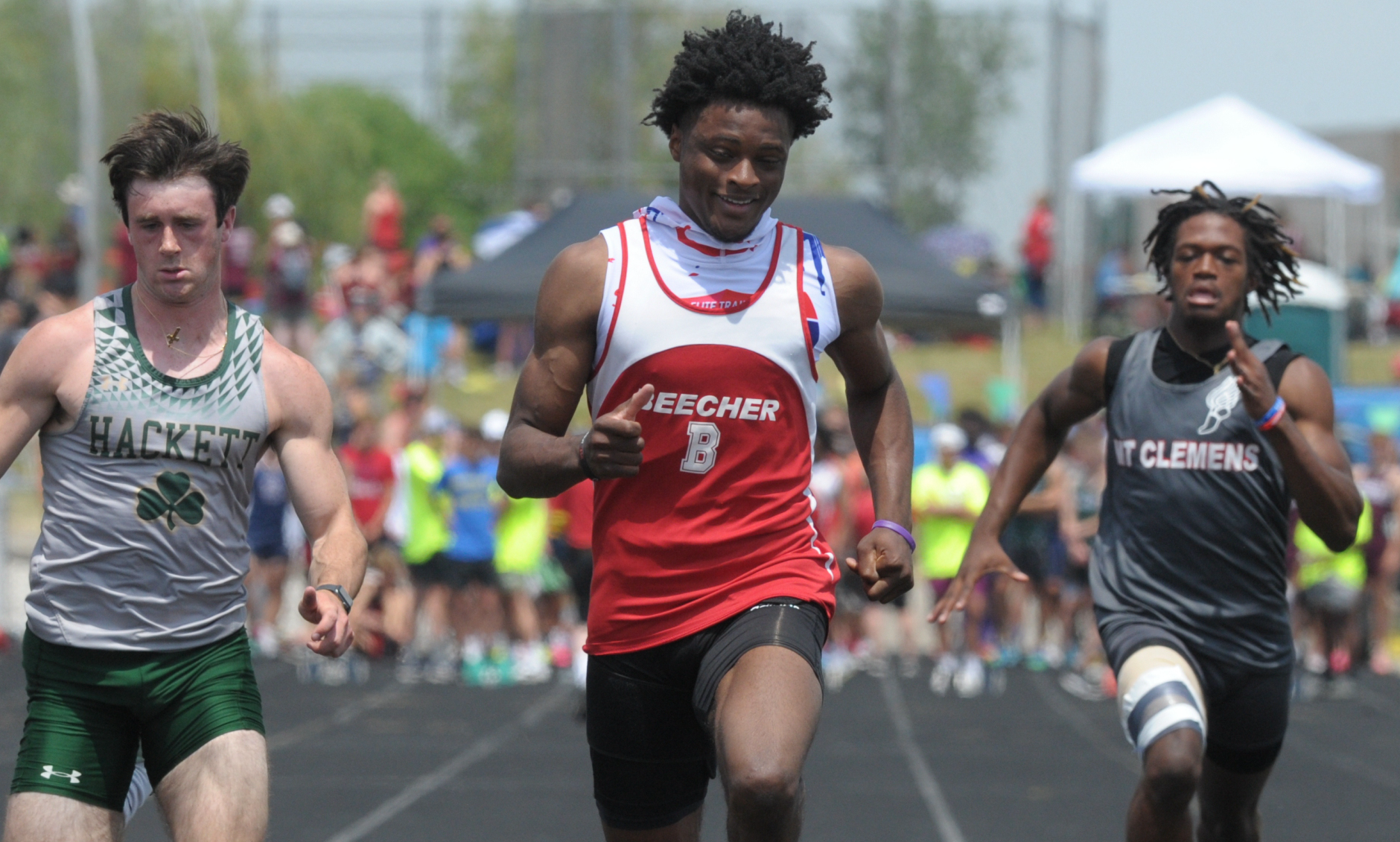
Smart Choices Pay Off for Sanford Meridian
May 31, 2014
By Butch Harmon
Special to Second Half
COMSTOCK PARK – The Sanford Meridian baseball team was down a man Saturday as it worked its way to a District title.
Senior Jacob Wenzlick was busy on the other side of the state, helping the Sanford-Meridian boys track and field team win the championship at the MHSAA Lower Peninsula Division 3 Finals.
Wenzlick was a member of three winning relay teams for the victorious Mustangs. He also is a member of the Mustangs baseball team and had a pair of hits in the District opener earlier in the week.
But the lure of a lofty finish at the Track and Field Finals had him on the track Saturday afternoon.
“This was just nuts,” Wenzlick said. “We didn't even win our conference or our Regional. To win a state championship is incredible.”
That Sanford-Meridian was in a position to win was pretty incredible.
Wenzlick was not the only assist the Mustangs’ track team received from the baseball team. Senior Dan Johnson, who played baseball last season, broke his wrist before the season this spring. Unable to play baseball, he decided to come out for the track team.
On Saturday, Johnson found himself running a leg on the 1,600 relay team that not only won but set a meet record in the process.
“This is my first year of running track, and it was awesome,” Johnson said.
The track team received an even bigger assist from the Sanford-Meridian basketball team. Seniors Kevin Scheibert and Jacob Ham are first-year runners and members of the basketball team. They were busy in previous springs playing travel basketball together to prepare for the next season.
But with their high school basketball careers finished, the duo was talked into coming out for the track team by Sanford-Meridian coach Dave Pettyplace.
Scheibert and Wenzlick stepped in to open vacancies on the 400, 800 and 1,600 relay teams and helped all three squads win championships Saturday.
“We had three guys who were in their first year running track,” Pettyplace said. “They were part of three relay teams that took first place and that was a big key.”
Another big key was a fifth-place performance from Ham in the 200-meter run. Seeded eighth, Ham told a teammate he was going to take it easy in the 200 to save himself for the 1,600 relay at the end. His teammate let him know that those points in the 200 would be key for the team, and Ham changed his game plan.
“Those points were pretty important,” Ham said. “I had the mile relay after that and I wasn’t going to try very hard, but when I was told we needed those points, I ran as hard as I could.”
A feeling he and Scheibert would not have enjoyed had it not been for his coaches’ recruiting efforts.
“Coach has always talked to me about coming out for track,” Ham said.
“I’m at a loss for words,” Scheibert said. “This was the first year for the two of us. We just came out for the fun of it never realizing we would get in this position.”
For New Haven junior Josh Harris, the Finals were a very special occasion. Not only did Harris win the 110 hurdles in a personal-best time of 14.96, but he also celebrated his 17th birthday.
“This has been a goal of mine since my freshman year,” Harris said. “I also made a promise to my deceased coach, coach Rob who coached me as a freshman, that I would do this for him. Doing this on my birthday just adds the icing on the cake.”
Harris just missed qualifying as a freshman and last season he did not run track as he played travel basketball instead.
“Once the race began I felt very loose and confident, “Harris said. “I had no nervousness at all.”
Union City junior Aaron Watson also missed out on the Finals last year. Watson suffered a torn hamstring early last season and was never at full strength.
Healthy this year, Watson not only made it but won the 100 dash in a personal-best time of 10.9.
“As a freshman I made it to state but I was knocked out in the prelims,” Watson said. “Last year in the first meet of the season I tore my hamstring. At the beginning of this season my goal was just to qualify for state. As the season went on I started setting my goals higher and higher.
“I came out of the blocks real good. The leaders kind of bunched up in the middle of the race, but then I pulled away at the end. I started strong and finished strong today.”
Thanks to some help from his teammate, Niles Brandywine senior Andrew Duckett came away with a championship in the 300 hurdles. Duckett turned in a winning time of 39.1 while his teammate, senior Nathan Anders, placed third.
“Finishing in the top three together is a big deal for us,” Duckett said. “It is so helpful having a teammate like Nathan. He pushes me in practice every day. Most teams don’t have that luxury.”
Almont sophomore Jacob Battani picked a good time to make a big improvement. Battani won the pole vault with a vault of 13-9, a nine-inch improvement over his previous personal record.
“I had a better invert today, and that was something I was working on all week in practice,” Battani said. “I’m really excited and happy. I was just hoping to make it to state this year. I was not expecting to finish first.”
Hopkins junior high jumper Quincy Collings went out for track for the first time last season. One year later he not only made it to the Finals but he won the high jump with a leap of 6-9, three inches better than his previous record.
“I’ve been working on my technique a lot lately,” Collings said. “I was told to back up when the height goes up to get over the bar, and I’m happy with the result. My goal was to clear 6-8 and finish in the top three.”
PHOTO: Sanford Meridian's Jacob Wenzlick carries the baton for one of his team's relays. (Click to see more from RunMichigan.com.)

Thrower Claims Lone Individual Title to Lead Hackett to Team 3-Peat
By
Tom Lang
Special for MHSAA.com
June 3, 2023
Kalamazoo Hackett Catholic Prep just keeps winning and winning.
This time the Irish took home their fourth title in the last five Lower Peninsula Division 4 Track & Field Finals, on Saturday at Hudsonville.
Hackett’s only individual title was taken by discus winner Nathan Buchmann, a senior, who was fine knowing he was the shortest in stature among all the sizable competitors.
“In the offseason after football I worked out every day, working towards this goal,” he said after getting his medal. “I would say this takes 80 percent technique and 20 percent strength to throw the discus. So, length can help but if you have good technique and are really strong, that will play into it.
“I think we are very balanced throughout the meet today,” he said about teammates that scored points in finishes other than first place. “We have 13 guys here today, and we have people in a lot of the races. But I do not run; I have too short of legs to be a fast runner,” he said with a chuckle.
Buchmann had to work through a hip injury to compete this spring.
“I think the setbacks are what make you strong,” he said. “You can either give up through the setbacks or push forward and become better.”
 Coach Charissa Dean agreed.
Coach Charissa Dean agreed.
“The kids have big hearts,” she said after all the points were totaled and the Irish were on top once again, with 53. “They worked hard. They had a lot of potential when we started the season. And we had a lot of drive to put in the work, and we are happy the results came out the way they did.”
Reading was runner-up at 47 points, followed by Wyoming Potter’s House Christian with 42, then Fowler and Flint Beecher each with 37 points.
Senior Lezawe “Moses” Osterink, of Potter’s House Christian, placed second in 1,600 but took the 3,200 title as defending champ of both. He dominated the latter by lapping the field with a final lap kick that resembled more of a superhero speedster.
“Nobody really took it out that hard at the start,” he said. “There was a freshman (Marek Butkiewicz of Hackett) that tried to get the pace going quick, but me and Dakota (Dykhuis of Montabella) just kind of sat back and gradually pulled him through.
“We took it gradually, and I was just relying that I could kick.”
Kick did he ever. The trio were neck and neck the majority of the race in a grouping ahead of the pack.
“With 400 to go I just tried to go all out,” Osterink said. “I had a lot more left than I thought and I was pleased with the win. Not really the time, but that doesn’t matter, especially this hot out.”
The overall meet was in the low 90s/high 80s heat and searing sun all day. So, race officials allowed the unique opportunity for coaches to spray the runners with water and give them water bottles.
“It was very weird because I’ve never taken water to drink while I’m running, so I didn’t know how that would feel,” Osterink said. “And they were spraying us and hitting us in the face. It was kind of fun.”
Junior Tyler Lenn of Marine City Cardinal Mooney defeated Osterink at his own game in the 1,600.
“I’m feeling great,” Lenn said after grabbing the medal. “I said to a newspaper after one of my races (during the season) I was right where I wanted to be. This has been a long rebuilding process for me since an injury back in the fall, and I set a pretty high goal the day the injury happened. I was telling myself I needed to fulfill what I said I would do at the beginning of last cross country season. And that is what I did today.”
Lenn suffered an ankle sprain from a misstep that turned worse because he kept running through the season on it.
“Coming back from that was pretty tough, but I wouldn’t have it any other way,” he said.  “Perseverance; I said from the beginning what I was going to do. I kept my eye on that target, and no matter the circumstances life threw at me, that I was going to make it happen and I am a man of my word.”
“Perseverance; I said from the beginning what I was going to do. I kept my eye on that target, and no matter the circumstances life threw at me, that I was going to make it happen and I am a man of my word.”
Jaylin Townsend, a senior from Flint Beecher, dominated the short races. He won the 100 dash (10.67) and 200 dash at 22 seconds flat. It was his third 100 win at a Finals.
“I put in a lot of work; I had to three-peat,” he said after the 100. “There’s a lot of great competition here, so I knew I had to come out and run my best.”
Concord in the 400 (43.72), Buckley in the 800 (1:30.76) and 1,600 (3:29.13) and Potter’s House in the 3,200 (8:14.18) were relay champs Saturday. Reading’s Tayshawn Bester won the 110 hurdles (15.13), and Athens’ Landen Bennett won the 300 (39.85). Caseville’s Nathan Feltner won the 400 (50.76), and Vestaburg’s Owen Patton claimed the 800 (1:55.11).
Fruitport Calvary Christian’s Bradley Richards won the high jump (6-10), and Peck’s Alex Affer won the long jump (23-4). McBain Northern Michigan Christian’s Isaac Bowden was first in pole vault (13-0), and Brown City’s Kyle Affer won shot put (49-2).
PHOTOS (Top) Kalamazoo Hackett Catholic Prep celebrates its third-straight LPD4 title Saturday. (Middle) Cardinal Mooney's Tyler Lenn, far right, sets the pace in the 1,600. (Below) Flint Beecher's Jaylin Townsend, middle, crosses the finish first for one of his two sprint championships. (Photos by Ken Swart/RunMichigan.com.)

